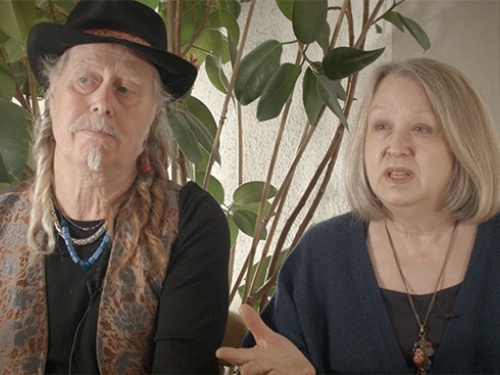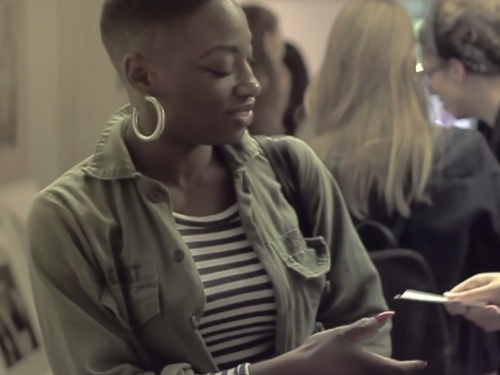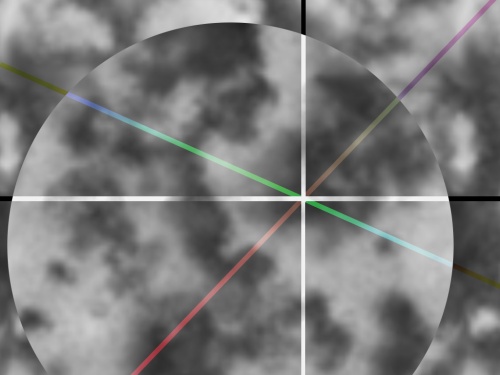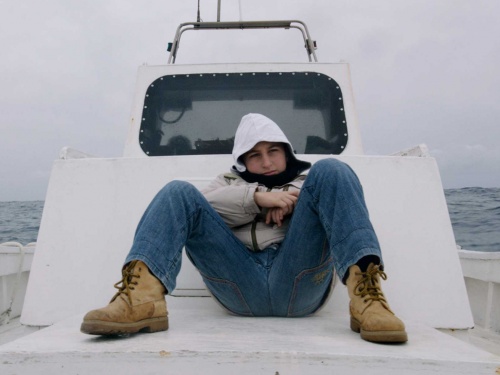Cally Spooner talks to Associate Curator Anna Gritz
Footnote 5: A Six Stage Manifesto On Action, is the fifth live event in Cally Spooner's eight month solo show, Collapsing In Parts, commissioned by International Project Space, Birmingham. Part musical theatre production, part live rehearsal for a prospective feature-length film, Footnote 5 takes the form of a sketch show for a solo performer, and multiple musicians. It develops Spooner's use of theatre as a site to stage the awkward relationship between discourse and the rhetorics of performance in the workplace.
Read an excerpt from Collapsing in Parts here.
What follows is a conversation between Cally Spooner and Anna Gritz, Associate Curator at ICA, in the context of Footnote 5.
“MORE WORDS, MORE WORDS HERE”
Q. Let's start by talking about the larger project that this footnote is a footnote to, can you talk a little about your project with the International Project Space Birmingham and how it has developed over the last year.
The larger project is called Collapsing In Parts and it's a solo show at International Project space, Birmingham, curated and produced by Andrew Bonacina, which I’ve been performing over eight months.
The spine of the solo show is a large piece of writing in eight parts, which has been written and published online throughout the duration of the show. It's going to be published as a novella at the end of the year.
The writing was a pretty solitary activity and to counterpose this, the project also includes a series of five live events which somehow act as related pieces of research, or 'footnotes' to the content of the writing. The writing itself is moving through three characters spread over three different decades of recessions, each of whom are more or less failing to perform due to various self-obsessive contemplative forms of neurosis. So, there's a Screenwriter with nothing to say, a Golfer who loses his competitive drive, and a Politician more preoccupied with his own appearance than his policies or public. The character's stories are interrupted regularly by a reoccurring Copy Editor, whose unimpressed comments on poor spelling, bad planning and socio-political progress, mean that the novella really doesn't move anywhere.
The footnotes exist alongside this evolving text as active or public spaces, rather than contemplative or isolated endeavours, and have been taking place at lots of host institutions and projects such as Hemes Und Der Pfau, Eastside Projects, LUX and the ICA, for Footnote 5.
Q. Your thinking about progress, productivity and the urge to perform in society and art lie at the core of this project. Looking back would you say that these can be described as continuous themes in your work?
Although they've not always obviously been themes I guess these ideas have always been there, in that all my older work has played on the behaviour of a performance/ production crisis, by staging this attempt at trying to find something to say and do, again and again by revising and re-performing itself in versions, acts, parts. So pre-IPS, the work had, perhaps, been dealing with these ideas structurally, although the content was about other things. For instance, the distinctions between speaking and text and their relationship to the museum or the relationship between live thinking, speaking, and architectural events, and always underpinned with an interest in the movement of speech.
Collapsing In Parts is definitely the first time I’ve explored ideas of progress, productivity and the urge to perform directly through the work's research content, and where I’ve been writing about these ideas explicitly. So, this is the first time that both the behaviour of the work, it's evolution, and it's content become about performance and production.
Q. Writing impacts on and features heavily in your work - do you think your writing style has changed since you started working on the text for IPS? If so how?
Yes, it has. The show at IPS was always rooted in a wish to stop writing scripts and dialogues, and try to write prose. This was mostly because I wanted to see if I could do it, hence the 'performance promise' of producing a large body of new writing that underpins Collapsing In Parts.
It was, in a way, about wanting to create a challenge of sorts, partly because the dialogues were starting to arrive quite naturally (I think, and also keep notes in multiple voices) and I wanted to see if I could make something more 'built'. In retrospect though, the bits that work in the novella are the dialogues between characters and the points when I’m really trying to craft bits of prose, and that craft finally arrives, are when the writing stops working, I think.
Q. Who is The Golfer?
The Golfer is one of three characters in the Collapsing In Parts writing. He's the second character to arrive, after the Screenwriter, and before the Politician.
All the characters are based loosely on pop-cultural figures, somehow detoured from these origins into total fiction. The Screenwriter arrives from a down-and-out F. Scott Fitzgerald, struggling to get active in Hollywood a decade after the stock Market crash. The Politician is a Reagan-esque pantomime figure proposing an impossible back to work-without-work scheme in the 1980s unemployment dip. And The Golfer is this rich, publicly popular loner fighting the unsporting demands of his newly appointed 'high performance' corporate coaches, against the backdrop of Lehman catastrophe and the last days of Tiger Woods' relationship with Accenture (a business to business performance company).
It wouldn't be fair to say the Golfer is Tiger Woods, because he's not. The Golfer's story is just derived from Woods' story, using this to spring-board into a fiction that can develop a narrative around this idea of solo performance, and what happens when one's solo performance shifts focus and has to fit needs beyond the practice itself - hence Woods' relationship to Accenture, and their role as corporate sponsors being a prime focus for the character's story.
For me the Golfer is the saddest of the characters. He's stuck in an impossible situation and has totally lost enthusiasm for the only thing he's able to do. I've grown quite attached to him, although I didn't know that would happen.
Q. To speak more specifically about Footnote 5, how does the footnote sit within the larger project Collapsing In Parts?
Footnote 5 is the last footnote event in Collapsing in Parts. It arrived at a point in the project where some pretty awkward questions around solo endeavours and certain forms of collective work were arising. So, Collapsing In Parts is a Solo show, and the writing has been developed on my own, but all the Footnote events have been made with other people. Essentially, each of them is a conversation with someone who I know pretty well; my students; artists Amy Spencer and Georgie Grace; the artist Giles Round; curator Richard Parry who performed in or contributed to Footnote 1; the artist Matthew McQuillan; who I wrote Footnote 2 with; Am Nuden Da, who I made a show with for Footnote 3; Sidsel Meineche Hansen who's an artist and researcher I’ve been developing a screening programme with since January, and finally, the actress Dulcie Lewis and artist/musician Peter Joslyn with whom I made Footnote 5. This final Footnote presented the tug between solo performance and collectivity; staging this complication, and extroverting it into hammy melodrama.
Q. From performing yourself in your earlier work you are now working closely with actors, amongst them especially Dulcie Lewis. Can you speak about what it means to work with actors and how it has influenced your practice?
Dulcie and I started working together in 2009, and that was the first time anyone else had arrived in my work. Before that it had been performance lectures, on my own. We began working together because delivering alone began to become about having something fixed and definitive to say, and even if there was some kind of ambiguity built into that delivery, the form of a solo performance/declaration was somehow conclusive and couldn't communicate this idea that the things I was thinking about were unresolved, and warrant to change. I wanted to find a way to destabilise my own position, and also have a conversation about the ideas with someone, that might throw my position out of focus, so I gave my monologue to Dulcie to deliver, then took on the role of an invasive impossible stage-direction, and interrupted her. We performed this to-and fro (her as the text, me as stage direction) for years, and since then I’ve started handing all my work over to other people to read different critical positions: as parts for players and as a way of presenting a number of contradictory positions and ideas simultaneously.
For Footnote 5, I took myself out of the work entirely which pushed me more into a directorial role, and freed me up to be a bit more ambitious with the production of the piece as a whole. The producer/director model is somehow equally or more problematic than the solo performer position though, and I’m not sure it’s one I’m totally comfortable with. In Footnote 5 I guess we dealt with this in that the whole piece is devised with Dulcie and Peter rather than written by me, solely.
I also think it's important to say that actually, I don't exactly work with actors. For instance I wouldn't hire an actor as material. I work with Dulcie because she is someone I'm having a long conversion with about notions of theatre, comedy, speaking, and she's also an actress. I don't think it would work if I just hired someone to read something or perform something for me, because it’s not just about that - it’s about being able to speak and work with someone and enjoy their company.
Q. Your work alternates between pieces staged for a live audience and pieces mediated through writing or recording. How do these differences register in your practice, and is there a hierarchy?
Although I have some film work which is recorded and some writing that never gets performed live, these registers are (generally) still operating under the same conditions as the live work for an audience. For instance, the prose writing in Collapsing In Parts is still using the principles of live performance to dictate its trajectory - I am not doing any major editing, and I’m not planning exactly what will happen. Also, I’m writing in real time - so almost documenting the act of the writing process and anything that arrives in my environment whilst I’m dealing with that. Equally my films aren't edited. They're always shot in straight takes though never to an audience, and whilst we might get through a few takes before its ready, we wouldn't alter the recording.
So, no, there isn't a hierarchy, because they're all still pretty much live.
Q. What role does conversation play in your work?
I think for most people a really good conversation is the starting point for a project or idea and it is for me too, but very often it's this conversation that becomes the material for the project. So for instance, the dialogue in Footnote 1 was developed through ongoing conversion with my students, Amy and Georgie which somehow extended out of their classroom, and the script for Footnote 5 was developed from a long devising process and a series of discussions around Hannah Arendt's concept of action (which itself is about the function of speaking in political action) with Dulcie, and then Peter.
Q. Do you think one can speak of a theatrical turn in contemporary art at the moment?
I'm not sure. I think yes, in a way, the devices and tropes of theatre have started to emerge a lot. There are loads of scripts being written and plays being performed by artists, especially here in London at the moment. There also seem to be a lot of curators and spaces using the tropes and familiar devices of theatre, such as It's moving from I to It by Form Content, which uses this idea of 15 Scenes to make an exhibition in parts. Also, Ariella Yedgar and Rosie Coopers' Inside the Whale: Act I - III which again uses the structure of acts or instalments to develop their exhibitions relating to Orson Welles' Moby Dick. I guess this borrowing of the aesthetic of theatre (the act, the scene, the programme notes) to make shows or works, may derive from an interest in the possibility of an exhibition or work existing in a different kind of time and space… so live, perhaps. But for me theatre isn't actually that 'live', in the sense that it's arrived. It's a fixed demonstration/re-presentation.
I think there is a really big distinction between - on the one hand a theatrical turn as theatrical aesthetic, and on the other, those who are using theatre to quite literally stage or re-present material (typically dead or archival material). I guess the best example in this case is Simon Fujiwara. I think the things he was making - even years ago when his work was still plainly architectural/sculptural - were still pure theatre, without necessarily being live. For me the theatrical is about setting up state; a fixed condition that stages and represents a point narrative or story, almost as a staged demonstration of that original. Keren Cytter's theatre company D.I.E now has also played a big role in this too. D.I.E 's work seems to be a pretty good use of theatre - in terms of using that space for saying and seeing; to demonstrate a story and psychological state.
But beyond all this I think a theatrical turn is different to an enquiry into performance. For me enquiries into performance are always linked to questions around production and productivity, and so I guess I'm saying a theatrical turn isn't the same as a performance turn. This might be exploring the notions of performance as a promise to deliver, and arrive or achieve, both in art and also outside the realm of art (in the work-place for instance). I guess Collapsing In Parts falls somewhere between the two, in that it's a project about theatricalising and staging that performance promise.
“LIGHTS OUT.”





